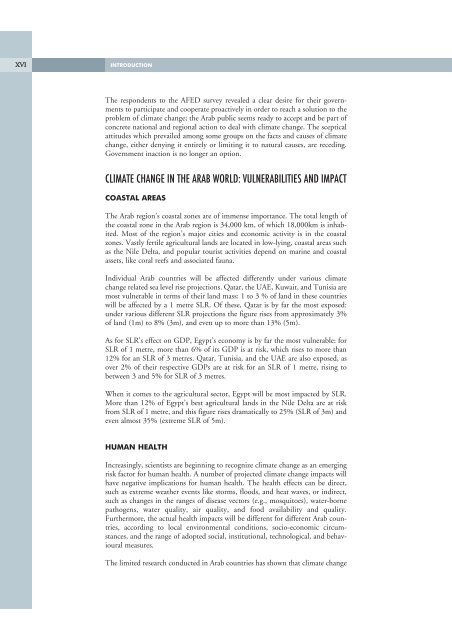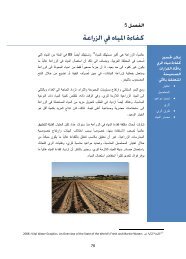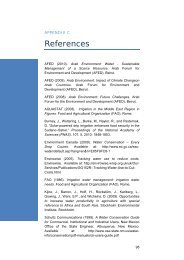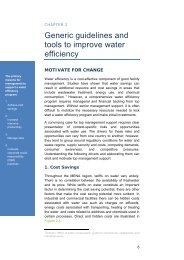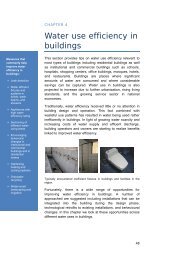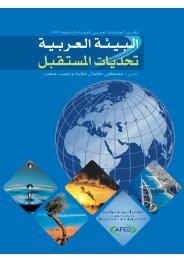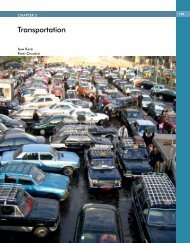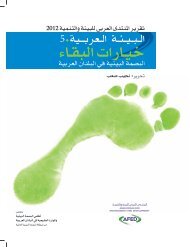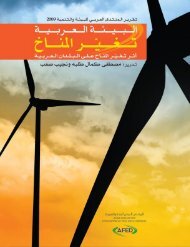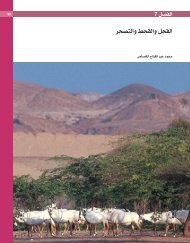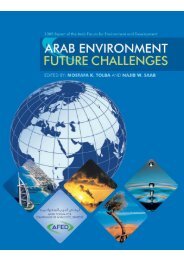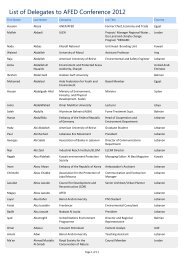Impact of Climate Change on Arab Countries - (IPCC) - Working ...
Impact of Climate Change on Arab Countries - (IPCC) - Working ...
Impact of Climate Change on Arab Countries - (IPCC) - Working ...
You also want an ePaper? Increase the reach of your titles
YUMPU automatically turns print PDFs into web optimized ePapers that Google loves.
XVI<br />
INTRODUCTION<br />
The resp<strong>on</strong>dents to the AFED survey revealed a clear desire for their governments<br />
to participate and cooperate proactively in order to reach a soluti<strong>on</strong> to the<br />
problem <str<strong>on</strong>g>of</str<strong>on</strong>g> climate change; the <strong>Arab</strong> public seems ready to accept and be part <str<strong>on</strong>g>of</str<strong>on</strong>g><br />
c<strong>on</strong>crete nati<strong>on</strong>al and regi<strong>on</strong>al acti<strong>on</strong> to deal with climate change. The sceptical<br />
attitudes which prevailed am<strong>on</strong>g some groups <strong>on</strong> the facts and causes <str<strong>on</strong>g>of</str<strong>on</strong>g> climate<br />
change, either denying it entirely or limiting it to natural causes, are receding.<br />
Government inacti<strong>on</strong> is no l<strong>on</strong>ger an opti<strong>on</strong>.<br />
CLIMATE CHANGE IN THE ARAB WORLD: VULNERABILITIES AND IMPACT<br />
COASTAL AREAS<br />
The <strong>Arab</strong> regi<strong>on</strong>’s coastal z<strong>on</strong>es are <str<strong>on</strong>g>of</str<strong>on</strong>g> immense importance. The total length <str<strong>on</strong>g>of</str<strong>on</strong>g><br />
the coastal z<strong>on</strong>e in the <strong>Arab</strong> regi<strong>on</strong> is 34,000 km, <str<strong>on</strong>g>of</str<strong>on</strong>g> which 18,000km is inhabited.<br />
Most <str<strong>on</strong>g>of</str<strong>on</strong>g> the regi<strong>on</strong>’s major cities and ec<strong>on</strong>omic activity is in the coastal<br />
z<strong>on</strong>es. Vastly fertile agricultural lands are located in low-lying, coastal areas such<br />
as the Nile Delta, and popular tourist activities depend <strong>on</strong> marine and coastal<br />
assets, like coral reefs and associated fauna.<br />
Individual <strong>Arab</strong> countries will be affected differently under various climate<br />
change related sea level rise projecti<strong>on</strong>s. Qatar, the UAE, Kuwait, and Tunisia are<br />
most vulnerable in terms <str<strong>on</strong>g>of</str<strong>on</strong>g> their land mass: 1 to 3 % <str<strong>on</strong>g>of</str<strong>on</strong>g> land in these countries<br />
will be affected by a 1 metre SLR. Of these, Qatar is by far the most exposed:<br />
under various different SLR projecti<strong>on</strong>s the figure rises from approximately 3%<br />
<str<strong>on</strong>g>of</str<strong>on</strong>g> land (1m) to 8% (3m), and even up to more than 13% (5m).<br />
As for SLR’s effect <strong>on</strong> GDP, Egypt’s ec<strong>on</strong>omy is by far the most vulnerable: for<br />
SLR <str<strong>on</strong>g>of</str<strong>on</strong>g> 1 metre, more than 6% <str<strong>on</strong>g>of</str<strong>on</strong>g> its GDP is at risk, which rises to more than<br />
12% for an SLR <str<strong>on</strong>g>of</str<strong>on</strong>g> 3 metres. Qatar, Tunisia, and the UAE are also exposed, as<br />
over 2% <str<strong>on</strong>g>of</str<strong>on</strong>g> their respective GDPs are at risk for an SLR <str<strong>on</strong>g>of</str<strong>on</strong>g> 1 metre, rising to<br />
between 3 and 5% for SLR <str<strong>on</strong>g>of</str<strong>on</strong>g> 3 metres.<br />
When it comes to the agricultural sector, Egypt will be most impacted by SLR.<br />
More than 12% <str<strong>on</strong>g>of</str<strong>on</strong>g> Egypt's best agricultural lands in the Nile Delta are at risk<br />
from SLR <str<strong>on</strong>g>of</str<strong>on</strong>g> 1 metre, and this figure rises dramatically to 25% (SLR <str<strong>on</strong>g>of</str<strong>on</strong>g> 3m) and<br />
even almost 35% (extreme SLR <str<strong>on</strong>g>of</str<strong>on</strong>g> 5m).<br />
HUMAN HEALTH<br />
Increasingly, scientists are beginning to recognize climate change as an emerging<br />
risk factor for human health. A number <str<strong>on</strong>g>of</str<strong>on</strong>g> projected climate change impacts will<br />
have negative implicati<strong>on</strong>s for human health. The health effects can be direct,<br />
such as extreme weather events like storms, floods, and heat waves, or indirect,<br />
such as changes in the ranges <str<strong>on</strong>g>of</str<strong>on</strong>g> disease vectors (e.g., mosquitoes), water-borne<br />
pathogens, water quality, air quality, and food availability and quality.<br />
Furthermore, the actual health impacts will be different for different <strong>Arab</strong> countries,<br />
according to local envir<strong>on</strong>mental c<strong>on</strong>diti<strong>on</strong>s, socio-ec<strong>on</strong>omic circumstances,<br />
and the range <str<strong>on</strong>g>of</str<strong>on</strong>g> adopted social, instituti<strong>on</strong>al, technological, and behavioural<br />
measures.<br />
The limited research c<strong>on</strong>ducted in <strong>Arab</strong> countries has shown that climate change


